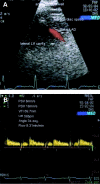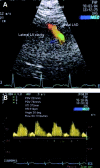Coronary flow reserve is supranormal in endurance athletes: an adenosine transthoracic echocardiographic study
- PMID: 10995406
- PMCID: PMC1729440
- DOI: 10.1136/heart.84.4.383
Coronary flow reserve is supranormal in endurance athletes: an adenosine transthoracic echocardiographic study
Abstract
Objective: To compare coronary flow reserve in endurance athletes and healthy sedentary controls, using adenosine transthoracic echocardiography.
Methods: 29 male endurance athletes (mean (SD) age 27.3 (6.6) years, body mass index (BMI) 22.1 (1.9) kg/m(2)) and 23 male controls (age 27.2 (6.1) years, BMI 23.9 (2.6) kg/m(2)) with no coronary risk factors underwent transthoracic echocardiographic assessment of distal left anterior descending coronary artery (LAD) diameter and flow, both at rest and during intravenous adenosine infusion (140 microg/kg/min).
Results: Distal LAD diameter and flow were adequately assessed in 19 controls (83%) and 26 athletes (90%). Distal LAD diameter in athletes (2.04 (0.25) mm) was not significantly greater than in sedentary controls (1.97 (0.27) mm). Per cent increase in LAD diameter following 400 microg sublingual nitrate was greater in the athletes than in the controls, at 14.1 (7. 2)% v 8.8 (5.7)% (p < 0.01). Left ventricular mass index in athletes exceeded that of controls, at 130 (19) v 98 (14) g/m(2) (p < 0.01). Resting flow among the athletes (10.6 (3.1) ml/min; 4.4 (1.2) ml/min/100 g left ventricular mass) was less than in the controls (14.3 (3.6) ml/min; 8.2 (2.2) ml/min/100 g left ventricular mass) (both p < 0.01). Hyperaemic flow among the athletes (61.9 (17.8) ml/min) exceeded that of the controls (51.1 (14.6) ml/min; p = 0.02), but not when corrected for left ventricular mass (25.9 (5.6) v 28.5 (7.4) ml/min/100 g left ventricular mass; NS). Coronary flow reserve was therefore substantially greater in the athletes than in the controls, at 5.9 (1.0) v 3.7 (0.7) (p < 0.01).
Conclusions: Coronary flow reserve in endurance athletes is supranormal and endothelium independent vasodilatation is enhanced. Myocardial hypertrophy per se does not necessarily impair coronary flow reserve. Adenosine transthoracic echocardiography is a promising technique for the investigation of coronary flow reserve.
Figures



Similar articles
-
Coronary vasodilator capacity and epicardial vessel remodeling in physiological and hypertensive hypertrophy.Hypertension. 2000 Sep;36(3):343-9. doi: 10.1161/01.hyp.36.3.343. Hypertension. 2000. PMID: 10988262
-
Coronary flow reserve improves after aortic valve replacement for aortic stenosis: an adenosine transthoracic echocardiography study.J Am Coll Cardiol. 2000 Nov 15;36(6):1889-96. doi: 10.1016/s0735-1097(00)00947-5. J Am Coll Cardiol. 2000. PMID: 11092661
-
Assessment of coronary flow reserve by adenosine transthoracic echocardiography: validation with intracoronary Doppler.J Am Soc Echocardiogr. 2002 Sep;15(9):984-90. doi: 10.1067/mje.2002.120982. J Am Soc Echocardiogr. 2002. PMID: 12221417
-
Noninvasive evaluation of flow reserve in the left anterior descending coronary artery in patients with cardiac syndrome X.Am J Cardiol. 2007 May 15;99(10):1378-83. doi: 10.1016/j.amjcard.2006.12.070. Epub 2007 Mar 28. Am J Cardiol. 2007. PMID: 17493464
-
Potential use of transthoracic echocardiography in the assessment of coronary flow reserve.J Am Soc Echocardiogr. 1999 Jul;12(7):590-5. doi: 10.1016/s0894-7317(99)70007-6. J Am Soc Echocardiogr. 1999. PMID: 10398918
Cited by
-
Effect of exercise training on endothelium-derived nitric oxide function in humans.J Physiol. 2004 Nov 15;561(Pt 1):1-25. doi: 10.1113/jphysiol.2004.068197. Epub 2004 Sep 16. J Physiol. 2004. PMID: 15375191 Free PMC article. Review.
-
The coronary circulation in exercise training.Am J Physiol Heart Circ Physiol. 2012 Jan 1;302(1):H10-23. doi: 10.1152/ajpheart.00574.2011. Epub 2011 Oct 7. Am J Physiol Heart Circ Physiol. 2012. PMID: 21984538 Free PMC article. Review.
-
Evaluation of non-invasive imaging parameters in coronary microvascular disease: a systematic review.BMC Med Imaging. 2021 Jan 6;21(1):5. doi: 10.1186/s12880-020-00535-7. BMC Med Imaging. 2021. PMID: 33407208 Free PMC article.
-
Effect of adrenergic agonists on coronary blood flow: a laboratory study in healthy volunteers.Physiol Rep. 2016 May;4(10):e12806. doi: 10.14814/phy2.12806. Physiol Rep. 2016. PMID: 27225628 Free PMC article.
-
The changes of pulmonary blood flow in non-ventilated lung during one lung ventilation.J Clin Monit Comput. 2010 Dec;24(6):407-12. doi: 10.1007/s10877-010-9262-0. Epub 2010 Nov 13. J Clin Monit Comput. 2010. PMID: 21076859
References
Publication types
MeSH terms
Substances
LinkOut - more resources
Full Text Sources
Miscellaneous
